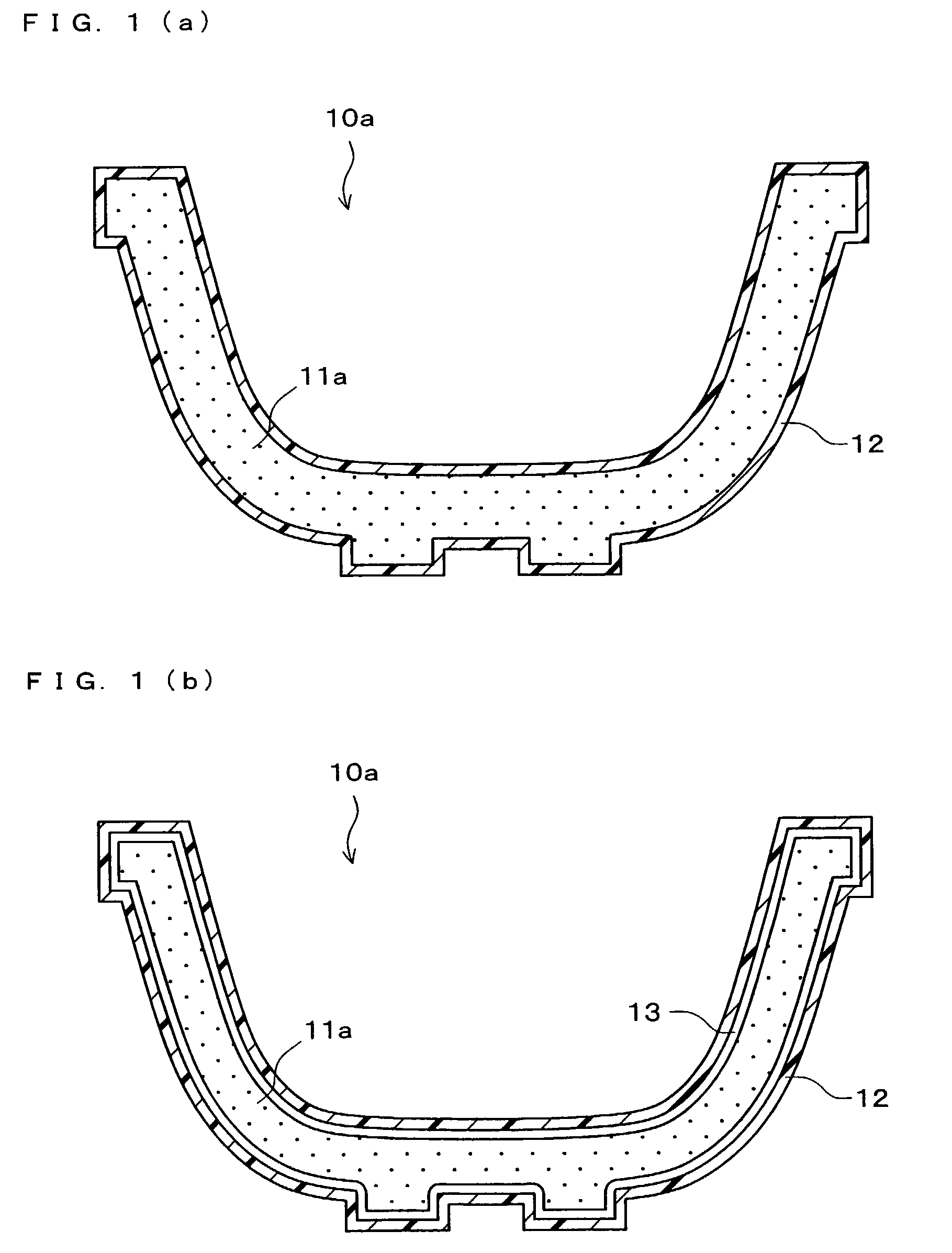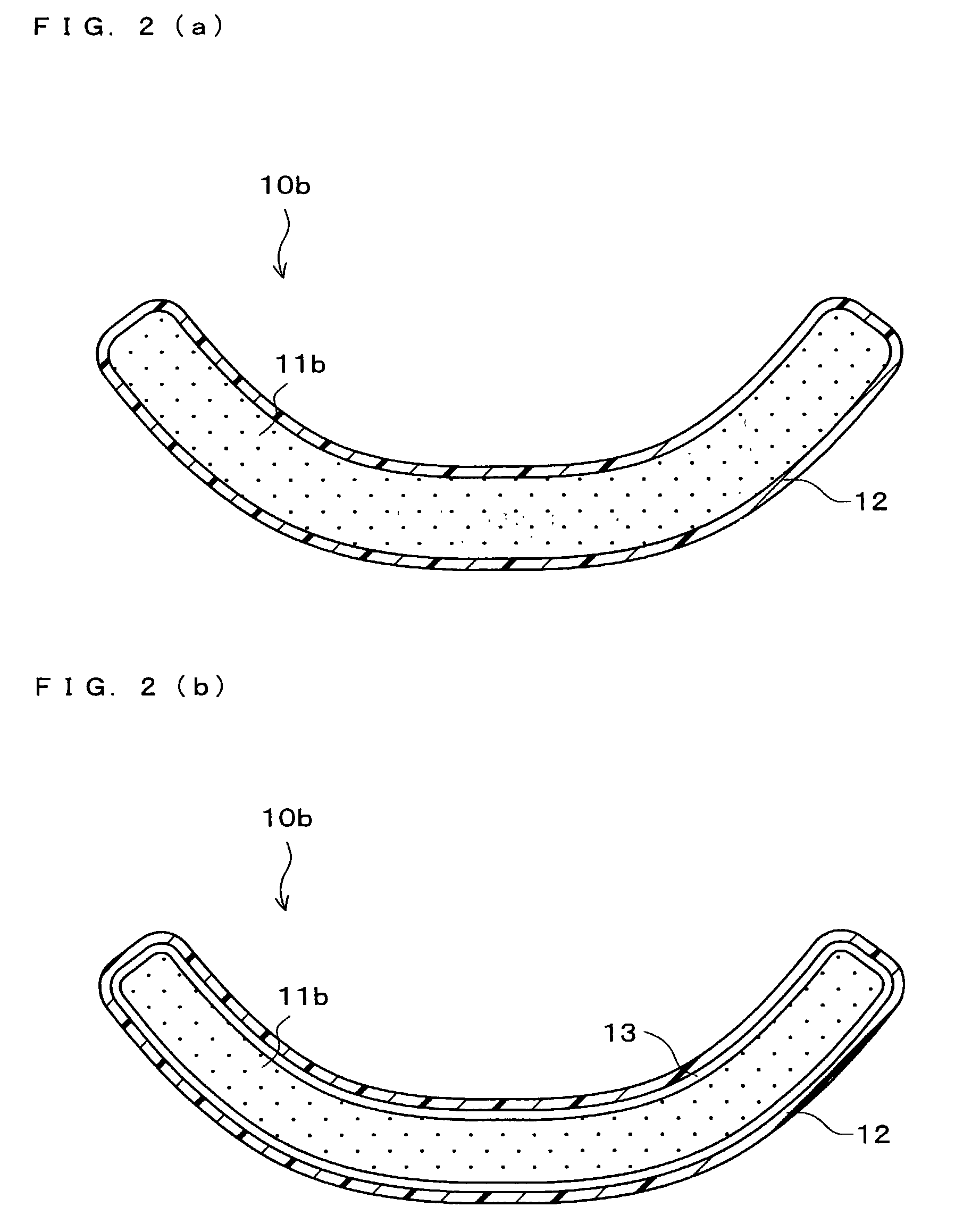However, the plastic molded article and the paper / pulp molded article both have difficulties to be used as the disposable molded article, as shown below.
First, when incinerated, the plastic molded article damages an incinerator because of the generation of extremely
high heat, or additionally produces evironmental contaminants such as dioxin.
Also, when the plastic molded article is buried for reclamation, it is impossible to bury the molded article where once the same is buried, since plastics almost never be decomposed naturally.
Moreover, due to a recent increase of the amount of waste, it has become difficult to secure new dumping sites year after year.
Furthermore, continuous environmental
pollution for a long period of time could be caused, since the plastic molded article cannot be decomposed easily.
Also, reserves of fossil fuels such as oil, which are raw materials of plastics, are decreasing year after year, so the plastic molded article could become more expensive in the future.
However, trees, of which paper and pulps are made, grow slowly and thus the
mass consumption of paper and pulps rapidly reduce forests.
The reduction of forest resources brings about not only heavy destruction of an environment of the area but also a great impairment of an ability of forests to absorb CO2 and a spur for
global warming because of the increase of CO2, from a broad perspective.
Usually the removal of the residues is washed in water, so this induces another
pollution such as an increase of the amount of polluted water and subsequent
water pollution in rivers and the sea.
Also, the recycling requires high cost, because the removal of the residues itself lowers the efficiency as it needs a lot of time and effort, and the
system of recycling has not been really socially established at the moment.
This is because the various biodegradable plastics have a problem that despite having a fine quality almost comparable to conventional plastics (non-degradable or degradation-retardant), practically they cannot be decomposed quickly enough.
For instance, when the thickness of a molded article made of the
biodegradable plastic is heavy, it takes very long time until the molded article is completely decomposed, so practically it is not possible to produce a molded article with enough volume.
However, actually it is difficult to
compost them together since the
biodegradable plastic above is only decomposed much slower than the food residues.
Furthermore, it is also difficult to crush the molded article to hasten the
decomposition of the biodegradable plastic, because normally the molded article cannot be crushed easily when it has a certain thickness and strength.
Thus it is almost impossible to
compost the molded article made of the biodegradable plastic.
However, at the same time the molded article derived from the technology (1) or (2) has the disadvantages that it can be used only for limited purposes and is required to barrier
moisture, due to its poor water and
humidity resistance.
However, the surface of the molded article (including expanded molded article) mainly made of starch cannot be completely smoothed, and generation of small irregularities cannot be avoided.
Thus small pinholes are likely to be formed on the surface in accordance with the irregularities if the resin is simply painted, so it could be possible to render the molded article
water repellent but difficult to make the same complete water proof.
So this introduces problems in terms of a manufacturing facility.
However, in this method it is required to remove the halogenated
hydrocarbon used to dissolve the
coating agent, and as in the case of the technologies (3) and (4), problems such as a requirement of equipment to prevent
diffusion of halogated
hydrocarbon arise.
Many halogenated hydrocarbons are often harmful for a
human body and the environment, and moreover the halogated
hydrocarbon that is concretely mentioned in the technology (5) contains CFC so that should be released to the air as little as possible.
Generally speaking, it is difficult to paint a water-resistant coating on the surface of the molded article evenly and entirely, while the coating on a flat molded article such as a flat plate is relatively easy.
However, small irregularities are likely to be formed on the surface of the molded article mainly made of starch as described above and obstruct the formation of an uniform film, and furthermore, the molded article or a painting device has to be rotated when the molded article is substantially circular in cross section, for instance formed like a cup or a bowl.
Therefore the painting becomes more difficult.
Besides, even if the coating agent can be painted evenly and entirely by using the dip method, the painted agent runs down before it solidifies and becomes the coating, and an unevenness is likely to show up.
However, at the same time the method has problems such as:the
biodegradation of the pulp-molding takes place slowly since it is made of
fiber so that the molded article cannot be disposed together with remaining foods, etc.
; andonly limited types of the molded article can be produced because it is difficult to make the molded article thicker, and also the molded article is not suitable for a
deep drawing.
Also, the technology (7) does not explain how the biodegradable plastic thin film is actually formed, such as by painting, by attaching already-formed film, etc., for instance.
Moreover, the technology (7) does not stipulate the coating state of the biodegradable plastic thin film with respect to the main body of the biodegradable container at all.
Furthermore, as already described, it is difficult to use biodegradable plastics as a thick molded article due to its slow
biodegradation, so the speed of the
biodegradation also greatly depends on not only the thickness of the molded article but also a total amount of biodegradable plastics contained in the molded article.
As a result, it is not possible to manage the biodegradation of the whole container favorably.
Now, as described in relation to technologies (3) to (5), when the
thermoplastic dissolved in the
solvent is used, problems such as a requirement of equipment to prevent
diffusion of the
solvent arise.
Thus it is impossible to mold molded articles such as a container with
deep drawing shape like a cup, molded articles having irregular thickness like a food tray with partitions and a wrapping tray, and molded articles having complex shape like
cushioning material for wrapping.
 Login to View More
Login to View More 


